AMD FX-8370E CPU Review: Vishera Down to 95W, Price Cuts for FX
by Ian Cutress on September 2, 2014 8:00 AM ESTGaming Benchmarks
F1 2013
First up is F1 2013 by Codemasters. I am a big Formula 1 fan in my spare time, and nothing makes me happier than carving up the field in a Caterham, waving to the Red Bulls as I drive by (because I play on easy and take shortcuts). F1 2013 uses the EGO Engine, and like other Codemasters games ends up being very playable on old hardware quite easily. In order to beef up the benchmark a bit, we devised the following scenario for the benchmark mode: one lap of Spa-Francorchamps in the heavy wet, the benchmark follows Jenson Button in the McLaren who starts on the grid in 22nd place, with the field made up of 11 Williams cars, 5 Marussia and 5 Caterham in that order. This puts emphasis on the CPU to handle the AI in the wet, and allows for a good amount of overtaking during the automated benchmark. We test at 1920x1080 on Ultra graphical settings.
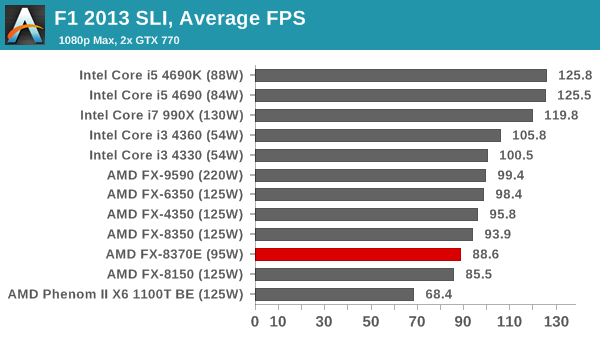
In all combinations, the 8370E and the 8150 duke it out. F1 2013 seems to be an Intel dominated title, given the i3 and outperform the FX-9590.
Bioshock Infinite
Bioshock Infinite was Zero Punctuation’s Game of the Year for 2013, uses the Unreal Engine 3, and is designed to scale with both cores and graphical prowess. We test the benchmark using the Adrenaline benchmark tool and the Xtreme (1920x1080, Maximum) performance setting, noting down the average frame rates and the minimum frame rates.
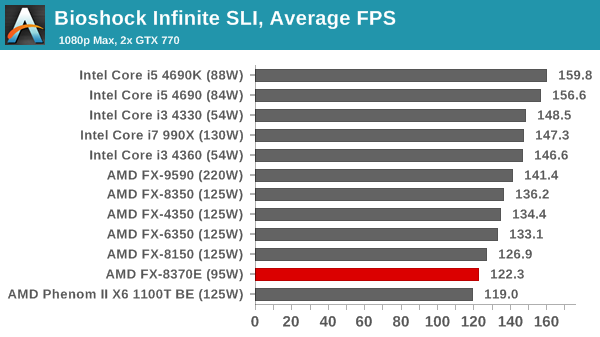
The FX-8350 again fits in just beneath the FX-8150, but for a lower power consumption.
Tomb Raider
The next benchmark in our test is Tomb Raider. Tomb Raider is an AMD optimized game, lauded for its use of TressFX creating dynamic hair to increase the immersion in game. Tomb Raider uses a modified version of the Crystal Engine, and enjoys raw horsepower. We test the benchmark using the Adrenaline benchmark tool and the Xtreme (1920x1080, Maximum) performance setting, noting down the average frame rates and the minimum frame rates.
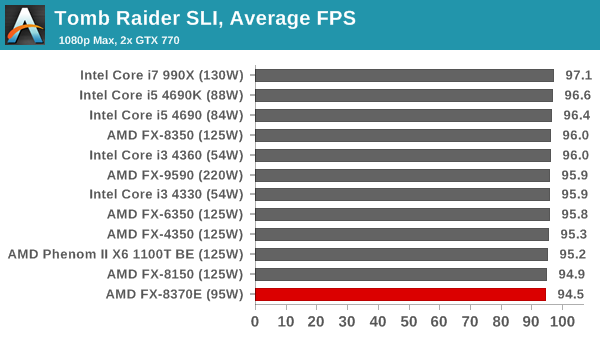
Tomb Raider continues to be CPU agnostic, even around the FX quad thread CPUs.
Sleeping Dogs
Sleeping Dogs is a benchmarking wet dream – a highly complex benchmark that can bring the toughest setup and high resolutions down into single figures. Having an extreme SSAO setting can do that, but at the right settings Sleeping Dogs is highly playable and enjoyable. We run the basic benchmark program laid out in the Adrenaline benchmark tool, and the Xtreme (1920x1080, Maximum) performance setting, noting down the average frame rates and the minimum frame rates.
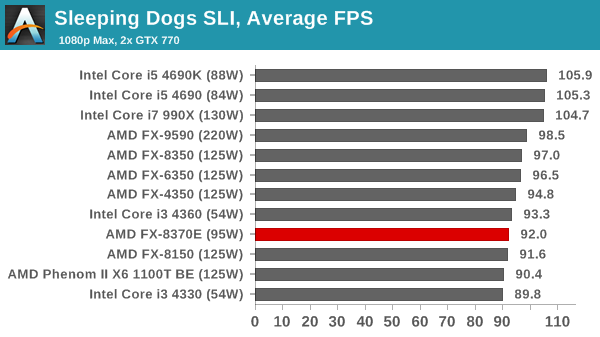
The eight threads offers some advantage in minimum frame rates, but average frame rates are still around the FX-8150.
Battlefield 4
The EA/DICE series that has taken countless hours of my life away is back for another iteration, using the Frostbite 3 engine. AMD is also piling its resources into BF4 with the new Mantle API for developers, designed to cut the time required for the CPU to dispatch commands to the graphical sub-system. For our test we use the in-game benchmarking tools and record the frame time for the first ~70 seconds of the Tashgar single player mission, which is an on-rails generation of and rendering of objects and textures. We test at 1920x1080 at Ultra settings.
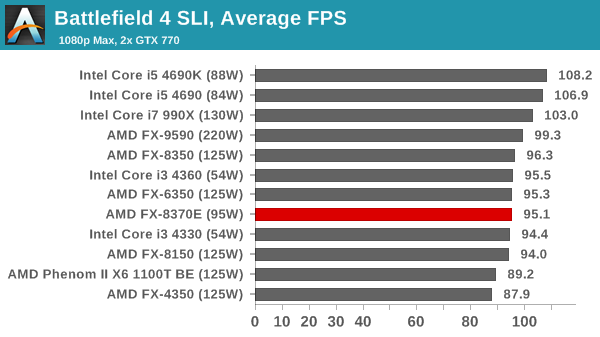
The FX-8370E stretches its legs a little in terms of minimum frame rates, particularly in SLI, however it is handily beaten by the i3-4330.















107 Comments
View All Comments
Vayra - Saturday, September 13, 2014 - link
It is not just Intel's fault though. AMD's marketing and timing is notoriously bad and has been for a long time. And they still keep fucking it up. Remember Mantle? Any other company would have been cashing in on that performance advantage, bigtime, even if it was only a couple percent. The only things that help AMD sales are factors beyond their control such as the sales bump on their GPU's when Bitcoin mining became popular.SunLord - Wednesday, September 3, 2014 - link
I doubt will see anything worthwhile from AMD let alone something that touches i7 until K12 ships. I can see them refreshing the FX chips next year using steamroller or a follow on core namely one that hopefully involves mostly 65W processors with 95w being the tdphescominsoon - Friday, October 17, 2014 - link
AMD isn't going to be able to get even with Intel(much less get ahead of them) until they move away form this two alu and 1 fpu per module garbage. The first gen Athlon has Intel running scared. All AMD can do now is compete on price..and they aren't doing that very well either. AMD is now facing what Intel was facing during the P-4 days. Hotter cpus that don't perform many things as well as the competition. AMD is a solid 2 generations behind in nearly all areas right now and with this current design they won't catch up.bebimbap - Tuesday, September 2, 2014 - link
searching on the net it seems the 8370 and the 8370e both OC the same. without the power limits it seems 4.7-5.0ghz for 1.45v is average for this cpu. so expect about a 20-25% OCability if your motherboard can supply enough powerif power/temps are not an issue one site even suggested the 8350 the better value buy.
though from the data it seems at the same voltage and same MHz the 8370e is much lower in temps compared to the 8350. could just be good chip lotto.
Sigh, i miss the old thoroughbred days.
Knowname - Monday, September 15, 2014 - link
my FM2 A10-7850 is twice as fast as my old Phenom x3 and it didn't cost much to upgrade even if it meant a whole new mobo. I'd no doubt go this route over an incremental upgrade using the old vishera design. My old Phenom x3 was AM2+ though, might want to double check your motherboard, if it IS just AM2+ you may have no choice! But have no fear, it is quite a bit snappier if you just go with the AMD APU. In fact if your uninterested in Mantle I'd just go with an old Trinity/ Richland design!Scionero - Saturday, December 27, 2014 - link
I know this is an old discussion but recent prices make this situation different. An Intel I5-4690k will almost always beat out an AMD 8370E, for example. But the AMD will be about 80% as powerful as the I5 at 60% of the price. If you need every last bit of processing power then go for the Intel CPU's, but for me the AMD is the clear winner for everyday tasks and gaming.blackmagnum - Tuesday, September 2, 2014 - link
Does this AMD chip have anything to do with this?: August 29th, The Haswell-E Launch.boot318 - Tuesday, September 2, 2014 - link
AMD doesn't even belong in the same sentence/paragraph/write-up/world/etc with that processor line. No, to answer your question. AMD is improving the power consumption of CPUs they already have out (3 years old now). Timing is just an coincidence with Intel's new Haswell-E launch.just4U - Tuesday, September 2, 2014 - link
Maybe.. but AMD gets a lot of criticism for it's power hungry processors so it's nice to see this get bumped down to 95watts. Intel's new line has 125watt cpu's which pretty much got a free pass in reviews. I found that odd.. especially with my 4790K coming in at 88watts.TiGr1982 - Tuesday, September 2, 2014 - link
I just bought and installed 4790K in my own Z87 desktop. The thing is that these 88 W in case of Intel are a typical, but not a very peak CPU wattage; e.g., my 4790K at 4.4 GHz on all the cores at 1.225 V consumes around 115 W in CPU-heavy tasks like Prime95 AVX 8 threads.So, take these 88 W "with a grain of salt".